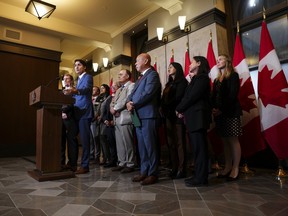The Institut du Québec think tank says that with unemployment rising, the provincial and federal governments are right to take steps to reduce the number of temporary residents.

The massive rise in temporary immigration to Quebec could hurt long-term productivity growth and push down wages in the province, according to a report by a Montreal-based think tank.
The Institut du Québec (IDQ) said that with unemployment rising, particularly among immigrants, the provincial and federal governments are right to take steps to reduce the number of temporary residents, arguing in the report released Wednesday that they should prioritize permanent immigration programs.
“Permanent immigration has historically had excellent results when it comes to economic integration,” said Emna Braham, the executive director of the institute. “We’re talking about immigration that is planned and that is aimed at addressing long-term economic development goals for Quebec and for Canada.”
A series of changes to temporary immigration programs — including those that allow employers to bring foreign workers to Canada for a limited period of time and those that allow international students to study in the country — was made to address labour shortages following the COVID-19 pandemic. The changes have led to a massive increase in the number of temporary residents in Quebec and the rest of the country.
This year, three times as many new temporary residents are expected to arrive in Quebec (more than 160,000) than new permanent immigrants (slightly less than 51,000), according to the report. Temporary residents accounted for 6.5 per cent of Quebec’s population as of July 1, more than double the number from three years earlier.
But the labour shortages that Quebec experienced by the end of the pandemic have almost completely disappeared, Braham said. She attributes that to population growth driven largely by the rise in temporary immigration and an economic slowdown in 2023, which reduced the number of posts employers were trying to fill.
“What we show in our report is that it’s mainly immigrants who have borne the brunt of the labour market slowdown, because it’s primarily their unemployment rate that has increased.”
According to the IDQ, the unemployment rate in Quebec for people born in Canada remained near all-time lows in September, at 4.6 per cent, but has increased significantly over the past two years to 11 per cent for recent permanent immigrants and to 12.5 per cent for temporary immigrants.
The rise in temporary immigration could have negative long-term impacts on Quebec’s economy, Braham said, because programs that allow employers to recruit workers from outside Canada are generally used to fill jobs that are unattractive to Quebecers, and employers who have come to rely on lower-paid workers from elsewhere will have less incentive to modernize their operations.
“So for an employer, having access to this labour can mean that instead of automating, instead of changing my business model, instead of changing the way I do things, I can continue to have access to this low-skilled labour and therefore I’m going to invest less, and that will eventually drag down the productivity of the economy as a whole,” she said.
The rising number of lower-paid foreign workers could also drive down the average wage in Quebec, Braham said.
Last week, the federal government announced it will reduce the number of both permanent and temporary immigrants Canada accepts over the next three years, forecasting slight population declines in 2025 and 2026. The move comes amid criticism that Canada’s rapidly growing population is reducing housing availability and affordability, as well as putting pressure on social services.
Braham said the Canadian and Quebec governments, which share responsibility for immigration in the province, seem to have somewhat lost control of immigration due to a lack of planning. She added their ability to pick immigrants has been eroded by programs that allow businesses and educational institutions to recruit internationally.
“There was a lack of co-ordination between the two governments, but also between the programs themselves,” she said.
Braham said governments don’t appear to have considered the effect that changing one program would have on others — for example, that allowing more international students to come to Canada would lead to an increase in the number of students applying for a program that allows graduates to temporarily stay and work here for several years.
“We probably still haven’t properly measured, in Quebec and in Canada, the total effect of all these adjustments,” she said.
Braham said the two levels of government should plan permanent and temporary immigration programs together, rather than treating them separately. She added she would like to see them prioritize permanent immigration programs, which have tended to favour highly qualified immigrants.
“Not only because of the positive impact on Quebec’s economy, in terms of productivity, in terms of wealth creation, but above all because they have the best chances of success,” she said.
But Braham warns that governments will have to be careful in their efforts to roll back changes to temporary immigration programs, so that closing one access point doesn’t lead to an increase in people coming through another. She also warns there will be a cost for the businesses and regions that have come to rely on international labour.